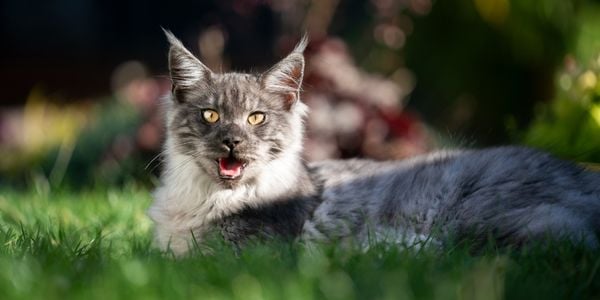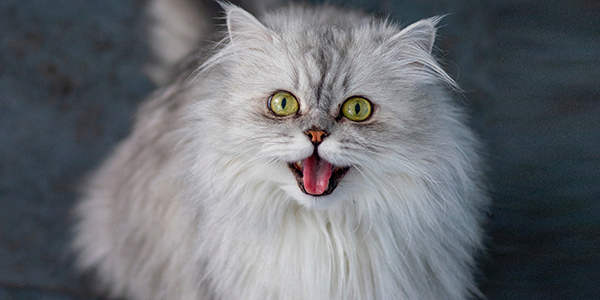Cats are known for many things. But panting isn’t one of them – typically.
So, does that mean if you observe your cat panting, you should immediately panic and rush them to the emergency room? The answer is maybe.
I know, I know, that isn’t the direct answer you wanted. But the reality is that it depends on the cause and how your cat responds to certain actions on your part.
There is ‘normal’ cat panting, and then there is cat panting that isn’t normal. And I will be the first to admit seeing your cat pant can be scary, and one’s knee-jerk reaction is to rush them to the emergency hospital. Learning what actions to take and when will hopefully help you both breathe easier.
What Does a Cat Panting Look Like?
Panting is generally associated with dogs. And to me, dogs and cats look quite different when they are panting.
This is what you will observe when your cat is panting:
- They have their mouth open – sometimes slightly, other times wide
- Unlike a dog, their tongue is only partially out and directly in front of their mouth
- They take short breaths in and out
- In some cases, they appear simply wide-eyed, and in others, their facial expression is more stressed and unrelaxed compared to their 'normal.'
You can see some video examples below in the Overexertion, Overheating, and Giving Birth sections.
When Is Cat Panting ‘Normal’?
There are instances where panting may be a normal response for a cat. Understanding when those times are and what steps are important for you to take may save your cat a trip to the veterinarian. However, while the following reasons for panting may be considered normal, some of these conditions can escalate to emergencies if not handled appropriately.
Overexertion
Just like physical activity can cause us (well, at least me!) to pant, it can do the same to a cat. If you notice your cat panting while running (chasing the laser pointer), playing (whether with a toy or another pet), or enjoying zoomies, attempt to get to them to stop, calm down, and rest. This may require moving them to a separate room that is quiet with no distractions.
Using a calming pheromone diffuser may be helpful too. Within a few minutes (no longer than 5 to 10 minutes), they should stop panting.
Here's a cat that's panting during a good romp with a feather toy. He starts really panting about 50 seconds into the video.
Stress, Anxiety, or Emotional Trauma
Everyone, including pets, react differently to triggers (loud noises), events (cat carrier, car ride, or vet visit), or environmental change (new pet or visitors). Identifying what things cause your cat stress, anxiety or trauma is important, and working to avoid them or lessen their impact is critical.
Being exposed to extended stress for too long can have a negative impact on your cat’s health (i.e., increase blood pressure, exacerbate feline interstitial cystitis, negatively affect behavior, and worsen pain).
Panting, in addition to shaking, vocalization, hiding, and bathroom accidents can all indicate your cat is stressed, anxious, or traumatized.
Removing your cat from the trigger and allowing them to be in their ‘safe’ place is the first step in getting them to calm down and relax. Once they feel safe, the panting should subside (typically within 15 minutes).
Overheating
Unlike dogs, cats don’t start panting as quickly when they are hot. If you suspect your cat is panting because they are hot, they are likely already quite overheated. It is important that you cool them down as soon as possible.
Bring your cat to a cool location where they can rest. Provide them with plenty of cool (not cold) water. Apply room temperature water to their fur and skin. If they tolerate it, you can have a fan gently blow on them.
Your cat should slow or stop panting within 5 to 10 minutes of starting cooling. If panting continues and they have any of the symptoms listed below, seek emergency veterinary care immediately.
- Drooling
- Very red or pale gums
- Vomiting
- Diarrhea
- Increased heart rate
- Lethargy
- Muscle tremors
- Seizures
- Collapse
Here's a cat panting from, most likely, the stress of being in the car and overheating. (BTW: A cat loose in the car is not recommended; it's not safe for anyone!)
Labor and Giving Birth
The process of labor and delivery involves aspects that can cause a cat to pant, for example, anxiety and pain.
Once your cat has completed the birthing process, she should begin to relax and stop panting. This video shows what normal panting looks like when a cat is giving birth or shortly afterward.
If you notice your cat continuing to pant, vocalize, or strain to push but a kitten is not delivered, seek veterinary care immediately.
When Cat Panting Is a Reason for Concern
There are quite a few conditions that can be associated with panting in cats. If a cat’s panting happens often and isn’t always clearly associated with exercise/exertion, stress, or increased environmental temperatures, then there’s a far greater chance that the panting is a result of one of these conditions and requires immediate veterinary care.
When you’re in doubt or concerned about your cat’s panting episodes, you should ALWAYS check with a veterinarian. Many of the conditions listed below can deteriorate rapidly, and some can even be quickly fatal. Fortunately, several can be well managed when caught and treated early enough.
Pain
It is very common for animals to pant when they are in pain. Any underlying disease or illness resulting in pain can cause a cat to pant. If your cat suddenly begins panting and there are no identifiable reasons (i.e., stress, exercise), evaluate them for signs of pain (i.e., biting and scratching, changes in breathing, heart rate, pulse and gum color, eye changes (dilated pupils). Do NOT give your cat human pain relievers.
Heart Disease
Heart disease in a cat can go undetected until the condition progresses and becomes urgent. Fluid can build up around the lungs when cats suffer from heart failure. Besides panting, cats may be weak and lethargic, lose weight, hide, wheeze, cough, their gums may be pale or bluish, and they may exhibit other signs associated with respiratory diseases.
- Heartworm disease (The heart and lungs are infected with worms)
- Hypertrophic cardiomyopathy A commonly diagnosed heart condition in cats characterized by a thickening of the heart wall, which affects the efficiency of the heart and causes issues in other parts of the body)
Respiratory Disease
Medical issues affecting the respiratory tract impair your cat’s ability to breathe normally as well as decrease levels of oxygen in the blood. This can result in panting as well as increased respiratory rate, coughing, difficulty breathing, and wheezing. Some respiratory diseases include:
- Asthma (chronic inflammation of the lungs)
- Bronchitis (inflammation of the lower airways)
- Pyothorax (infection within the chest cavity, surrounding the lungs)
- Pleuritis (inflammation of the lungs)
- Pneumonia (inflammation of the lungs and airways that is typically caused by an infectious (bacterial, viral, fungal, or parasitic) agent but can be due to aspiration (foreign matter inhaled into the lungs)
Anemia
Red blood cells deliver oxygen to the tissues in the body. When a cat is anemic, there are insufficient healthy red blood cells in circulation. This results in poor oxygenation of bodily tissues. Cats will be weak, have increased heart and respiratory rates, pale mucous membranes, and pant when it occurs.
Some causes of anemia in cats include:
- Internal or external blood loss
- Parasites: fleas, ticks, intestinal worms
- Tumors
- Ulcers
- Accidents or injury
- Toxins
- Ingestion of foods such as onions or garlic
- Some medications
- Heavy metals
- Infections
- Diseases (e.g., kidney disease, feline leukemia virus, feline immunodeficiency virus)
- Malnutrition
Diaphragmatic Hernia
A tear or hole within the diaphragm (the muscle wall that separates the chest cavity from the abdominal cavity), as a result of a congenital defect or trauma, allows for organs or tissue from the abdomen to move into the chest cavity.
When this occurs, it prevents the lungs from properly expanding, which affects your cat's breathing. Due to the decrease in lung capacity and possibly pain, cats may pant.
Poisoning
Cats are sensitive to many things dogs are not and, therefore, can more commonly suffer from the toxic effects of certain drugs, foods, or plants. The toxic effects caused by these things can potentially affect your cat’s respiratory center and alter their lung expansion leading to breathing issues. In these cases, the only evidence you may have that your cat has gotten into something poisonous (e.g., rat poison, insecticides, etc.) is their panting.
Foreign Body
During play, while out hunting, or even eating, your cat can swallow or inhale a foreign object. That object could end up lodged in their throat or further down their airway and cause them to pant due to the pain and obstruction of the airway.
Endocrine Disease
Your cat's thyroid regulates their metabolic rate. Cats with hyperthyroidism have an elevated metabolic rate; despite eating well, they lose weight.
The condition can also cause agitation, restlessness, poor hair coat, high blood, as well as other symptoms. It can cause cats to become heat and stress-intolerant, which can lead them to pant. If left untreated, cats will generally develop progressive heart disease and congestive heart failure, which, as mentioned, cause panting.
When the condition is not diagnosed or well managed, cats can suffer a “thyroid storm” (acute thyrotoxicosis). During a “thyroid storm,” cats may pant due to their rapid heart rate, discomfort, and high temperature (other symptoms include yellowing of the skin (jaundice), diarrhea, agitation, disorientation, and loss of consciousness).
Central Nervous System (think 'brain) Diseases
Panting can be due to trauma, tumors, infections, and other issues within their central nervous system.
Conditions Resulting in 'Acid-Base Imbalances' (diabetic ketoacidosis and urinary obstruction)
Panting can result from the acid-base imbalance, as well as the pain and abnormal heart rhythms associated with a blocked urinary tract). Read more about diabetes and diabetic ketoacidosis, and urinary obstruction in cats.
Fever/Hyperthermia
Medical issues caused by an infection, cancer, or another problem can lead to elevations in your cat’s temperature. To cool themselves, cats will pant.

I hope this has provided a somewhat direct answer to the question about why and what to do when your cat is panting. Remember, when in doubt, have your cat checked out by a veterinarian.





